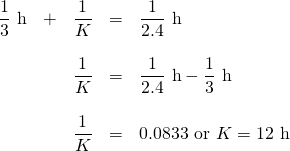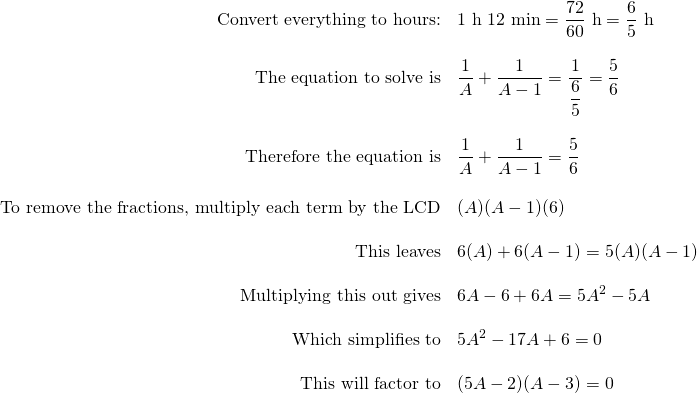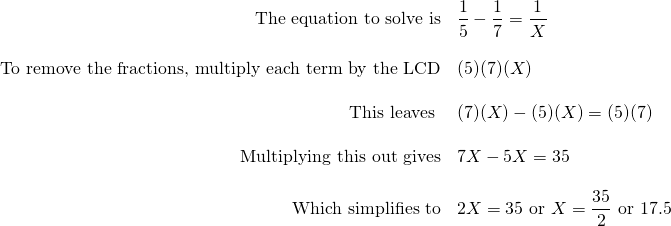Chapter 9: Radicals
9.10 Rate Word Problems: Work and Time
If it takes Felicia 4 hours to paint a room and her daughter Katy 12 hours to paint the same room, then working together, they could paint the room in 3 hours. The equation used to solve problems of this type is one of reciprocals. It is derived as follows:
![]()
For this problem:

To make this into a solvable equation, find the total time ![]() needed for Felicia and Katy to paint the room. This time is the sum of the rates of Felicia and Katy, or:
needed for Felicia and Katy to paint the room. This time is the sum of the rates of Felicia and Katy, or:

Example 9.10.1
Karl can clean a room in 3 hours. If his little sister Kyra helps, they can clean it in 2.4 hours. How long would it take Kyra to do the job alone?
The equation to solve is:

Example 9.10.2
Doug takes twice as long as Becky to complete a project. Together they can complete the project in 10 hours. How long will it take each of them to complete the project alone?
The equation to solve is:

This means that Becky’s rate is ![]() .
.
Since Doug’s rate is twice Becky’s, the time for Doug is ![]() .
.
Example 9.10.3
Joey can build a large shed in 10 days less than Cosmo can. If they built it together, it would take them 12 days. How long would it take each of them working alone?

Cosmo can build the large shed in either 30 days or 4 days. Joey, therefore, can build the shed in 20 days or −6 days (rejected).
The solution is Cosmo takes 30 days to build and Joey takes 20 days.
Example 9.10.4
Clark can complete a job in one hour less than his apprentice. Together, they do the job in 1 hour and 12 minutes. How long would it take each of them working alone?

The apprentice can do the job in either ![]() h (reject) or 3 h. Clark takes 2 h.
h (reject) or 3 h. Clark takes 2 h.
Example 9.10.5
A sink can be filled by a pipe in 5 minutes, but it takes 7 minutes to drain a full sink. If both the pipe and the drain are open, how long will it take to fill the sink?
The 7 minutes to drain will be subtracted.

17.5 min or 17 min 30 sec is the solution
Questions
For Questions 1 to 8, write the formula defining the relation. Do Not Solve!!
- Bill’s father can paint a room in 2 hours less than it would take Bill to paint it. Working together, they can complete the job in 2 hours and 24 minutes. How much time would each require working alone?
- Of two inlet pipes, the smaller pipe takes four hours longer than the larger pipe to fill a pool. When both pipes are open, the pool is filled in three hours and forty-five minutes. If only the larger pipe is open, how many hours are required to fill the pool?
- Jack can wash and wax the family car in one hour less than it would take Bob. The two working together can complete the job in 1.2 hours. How much time would each require if they worked alone?
- If Yousef can do a piece of work alone in 6 days, and Bridgit can do it alone in 4 days, how long will it take the two to complete the job working together?
- Working alone, it takes John 8 hours longer than Carlos to do a job. Working together, they can do the job in 3 hours. How long would it take each to do the job working alone?
- Working alone, Maryam can do a piece of work in 3 days that Noor can do in 4 days and Elana can do in 5 days. How long will it take them to do it working together?
- Raj can do a piece of work in 4 days and Rubi can do it in half the time. How long would it take them to do the work together?
- A cistern can be filled by one pipe in 20 minutes and by another in 30 minutes. How long would it take both pipes together to fill the tank?
For Questions 9 to 20, find and solve the equation describing the relationship.
- If an apprentice can do a piece of work in 24 days, and apprentice and instructor together can do it in 6 days, how long would it take the instructor to do the work alone?
- A carpenter and his assistant can do a piece of work in 3.75 days. If the carpenter himself could do the work alone in 5 days, how long would the assistant take to do the work alone?
- If Sam can do a certain job in 3 days, while it would take Fred 6 days to do the same job, how long would it take them, working together, to complete the job?
- Tim can finish a certain job in 10 hours. It takes his wife JoAnn only 8 hours to do the same job. If they work together, how long will it take them to complete the job?
- Two people working together can complete a job in 6 hours. If one of them works twice as fast as the other, how long would it take the slower person, working alone, to do the job?
- If two people working together can do a job in 3 hours, how long would it take the faster person to do the same job if one of them is 3 times as fast as the other?
- A water tank can be filled by an inlet pipe in 8 hours. It takes twice that long for the outlet pipe to empty the tank. How long would it take to fill the tank if both pipes were open?
- A sink can be filled from the faucet in 5 minutes. It takes only 3 minutes to empty the sink when the drain is open. If the sink is full and both the faucet and the drain are open, how long will it take to empty the sink?
- It takes 10 hours to fill a pool with the inlet pipe. It can be emptied in 15 hours with the outlet pipe. If the pool is half full to begin with, how long will it take to fill it from there if both pipes are open?
- A sink is ¼ full when both the faucet and the drain are opened. The faucet alone can fill the sink in 6 minutes, while it takes 8 minutes to empty it with the drain. How long will it take to fill the remaining ¾ of the sink?
- A sink has two faucets: one for hot water and one for cold water. The sink can be filled by a cold-water faucet in 3.5 minutes. If both faucets are open, the sink is filled in 2.1 minutes. How long does it take to fill the sink with just the hot-water faucet open?
- A water tank is being filled by two inlet pipes. Pipe A can fill the tank in 4.5 hours, while both pipes together can fill the tank in 2 hours. How long does it take to fill the tank using only pipe B?

